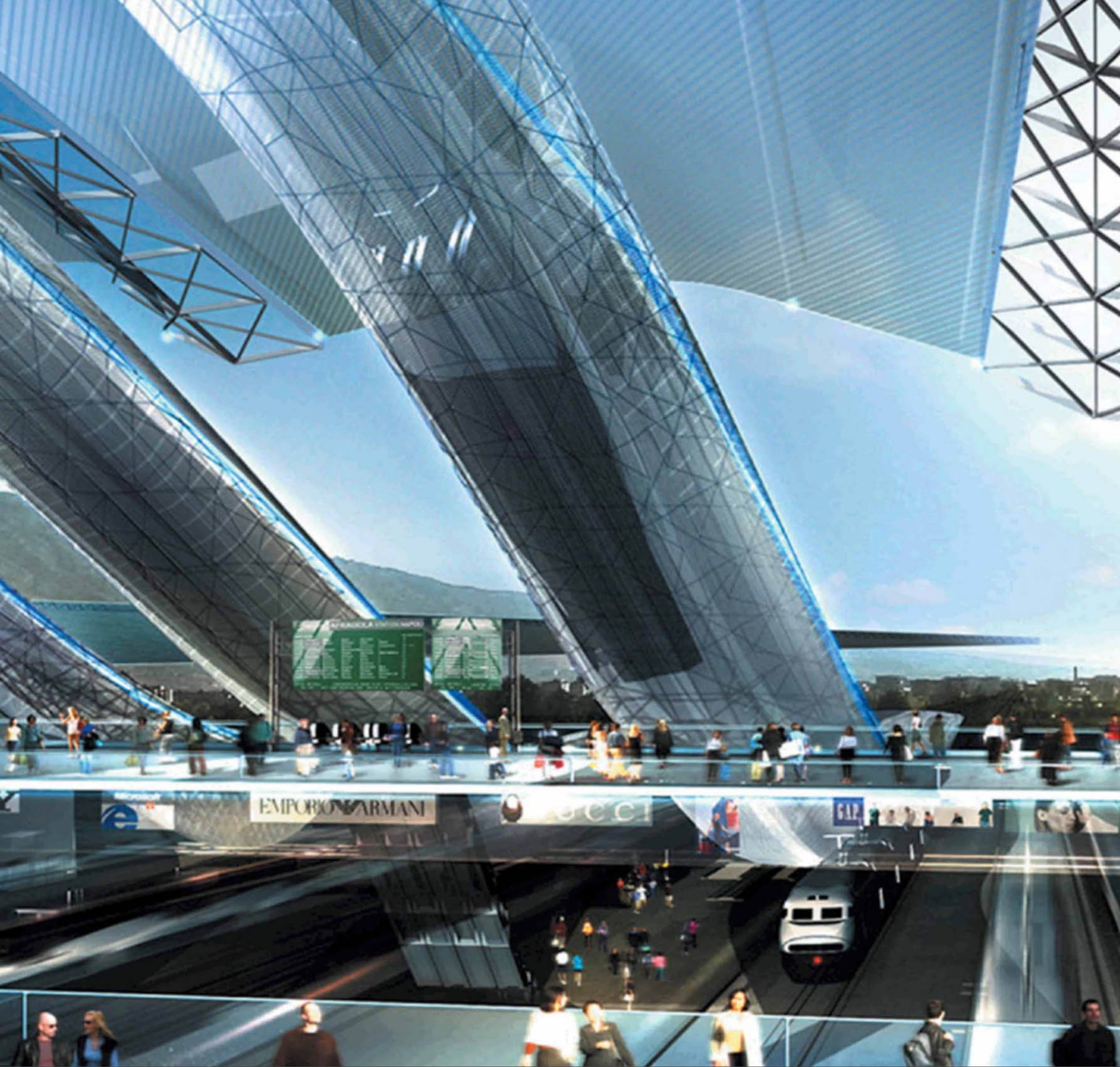
L’obiettivo del progetto è creare un’immagine nel paesaggio unica e riconoscibile, che unisca la natura “lineare” dell’alta velocità con la natura “figurativa” del Vesuvio, assunto come punto di riferimento. L’architettura della stazione sembra erompere dalla pianura “sollevando” campi e frutteti.
Treni e auto scivolano dentro e sotto la struttura. Più che sovrapposta, la stazione risulta essere innestata nel paesaggio. Le funzioni sono ospitate in due blocchi a nord e a sud del principale sottopassaggio pedonale della ferrovia. uffici e spazi commerciali sono allineati e connessi con la galleria commerciale centrale. Il verde agricolo circostante è ridisegnato secondo un modello a bande alterne di colture diverse e di piantumazione a foresta, seguendo un orientamento anticamente romano della valle.
Questi elementi, con la lirica copertura del tetto principale e i condotti strutturali, uniscono all’idea di tecnologia e di velocità riferimenti figurativi al Cristo velato di Giuseppe Sanmartino nella Cappella Sansevero, nella sua ambiguità a trasparenza.
The intent of the project is to create a single, recognizable image on the landscape that combines the “linear” nature of high speed with the “figurative” nature of Mount Vesuvius, which is the landmark. The architecture of the station seems to erupt from the plain, “lifting” fields and orchards. Trains and cars slide behind and under the structure. Rather than being superimposed, the structure is inserted in the sourroundings.
The services are hosted in two blocks north and south of the main pedestrian undeground passage at the railroad station. The offices and retail outlets are aligned and connected with the central shopping arcade. The sourrounding agricultural area has been redesigned using a model of alternate strips of different crops and forest plants, following the antique Roman direction of the valley.
These elements, with the lyrical covering of the main roof and the structural conduits, combine the idea of technology and speed with figurative references to the Cristo velato by Giuseppe Sanmartino in the Sansevero Chapel, in its transparent ambiguity.
Autori/Authors: Eisenman Architects
Peter Eisenman nasce nel 1932 a Newark, USA, studia architettura presso la Cornell University di Ithaca, nel 1959 ottiene il Master alla Columbia University e nel 1963 il dottorato a Cambridge, Inghilterra. Nel 1967 fonda l’Institute of Architecture and Urban Studies che dirige fino al 1982. Tra il 1973 il 1984 dirige il trimestrale Opposition.
E’ stato l’anima teorica dei New York Five, presentati nel 1969 da Kenneth Frampton al MoMA di New York. Dal 1982, oltre a un’intensa attività accademica nelle maggiori università americane ed europee, si dedica all’attività professionale. Le prime realizzazioni importanti sono le residenze IBA al Checkpoint Charlie a Berlino e Wexner Center of Visual Artas, Ohio.
Il suo studio di New York, che dal 1987 prende il nome di Eisenman Architects, si afferma poi con grandi progetti per istituzioni culturali e numerosi piani residenziali e urbanistici. Fra i progetti recenti si ricordano la Città della Cultura a Santiago de Compostela e il Museo dell’Olocaustoa Berlino.
Born in 1932 in Newark (USA), he studied architecture at the Cornell University in Ithaca, received a Master’s degree from Columbia University in 1959 and a Ph.D. from Cambridge, England in 1963. In 1967 he established the Institute of Architecture and Urban Studies, which he directed until 1892. Between 1973 and 1984 he was the editor-in-chief of the Oppositions quarterly magazine.
He was the theoretic mind of the New York Five, presented in 1969 by Kenneth Frampton at MoMA in New York. In addition to his busy academic work at leading U.S. and European universities, he has been practicing intensively his profession since 1982. His first notewhortly projects were IBA social housing at Checkpoint Charlie in Berlin and the Wexner Center of Visual Arts, Ohio.
His practice in New York, which became Eisenman Architects in 1987, has earned a reputation for its large-scale projects for cultural and educational insitutes and numerous residential and urban schemes. Recent projects include the Cultural Center in Santiago de Compostela and the Holocaust Memorial in Berlin.
